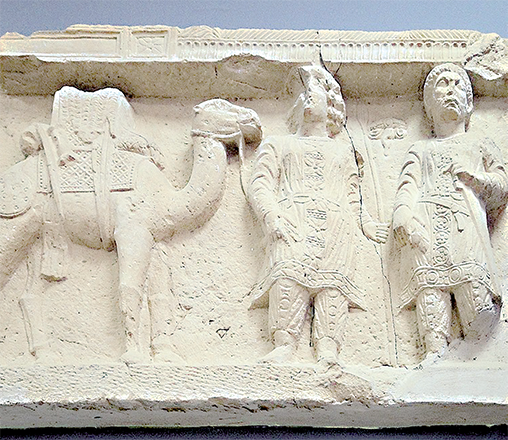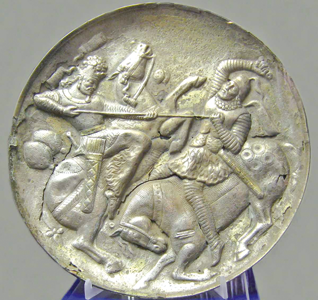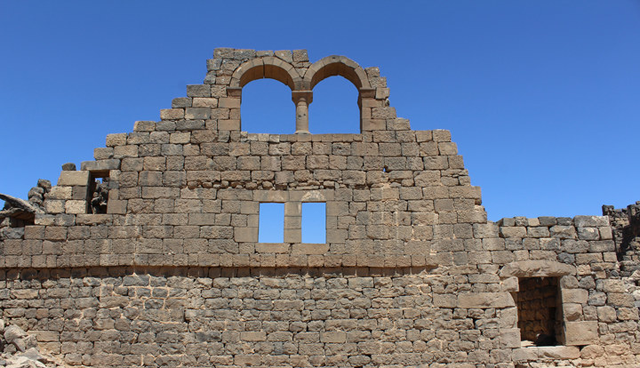You are here
Dromedarii soldiers: Delving into camel-riders in Eastern Roman Empire
By Saeb Rawashdeh - May 13,2024 - Last updated at May 13,2024

A camel caravan with a dromedar, camel herder and soldier (Photo courtesy of Palmyra Museum)
AMMAN — The Roman Empire in the Middle East recruited so-called “dromedarii”, who were camel-riding soldiers in the desert provinces of the empire to replace classical cavalry.
In this harsh arid climate, camels were often more useful than horses and dromedarii were both part of the transport and fighting units.
The Roman Emperor Trajan (rule: 98AD–117AD) established 1000 strong dromedarii unit in Roman Syria. The practice of the empire was to include auxiliary units of locals into a regular Roman army and dromedarii played a significant role in the war efforts against Parthian and Sassanid states.
A Greek historian, Diodorus Siculus, from the 1st century BC also mentioned camels as essential beasts of burden in the Eastern Mediterranean due to their carrying capacity and low maintenance needs.
According to Diodorus, camels could travel 200 kilometres without any stop.
Pliny the Elder
(23 AD–79AD) claimed that camels could endure thirst for four days.
Commemorating the vassalisation of the Nabataean Kingdom to the Roman Republic, the Nabataean King Aretas III minted coins in 58BC in which he kneels in front of a camel.
“It is quite clear that camel riders were not permanently employed as combat troops. The trading city of Palmyra, located in Syria, had dromedarii units deployed there but a recently discovered military diploma from 126AD shows that they were part of Arabia garrison,” noted the historian Duncan Campbell, adding that some members who were serving in the Roman units earned the Roman citizenship after 25 years.
In the eastern provinces, Roman army units often contained a few camel riders, who were usually attached to a cohors equitata.
Between thirty-two and thirty-six dromedarii are listed in the rosters of cohors XX Palmyrenorum equitata at Dura-Europos in the early 3rd century AD during the campaign of emperors from the Severian dynasty against Partians, and one or two were sent on missions with the cavalry and infantry.
“There was no consistency in the organisation of the dromedarii as either infantry or cavalry.
This probably depended on the systems in place in each province. The 1,000 — strong unit just described was categorised as an ala, whereas the camel riders in cohors XX Palmyrenorum in Syria were attached to the infantry centuries,” Cambell said, adding that their names were commonly listed at the end of each entry after all the other infantry soldiers, but in Egypt, a dromedarius called Cronius Barbasatis was assigned to the cavalry turma of the decurion Salvianus.
Salvianus was a volunteer and had not been transferred from another unit, so his skills were presumably recognised immediately on enlistment. However, it is generally considered that a dromedarius would usually enlist as an infantryman and serve for a few years in that capacity before becoming a camel rider.
Eastern auxilia, like those raised in the West, served throughout the empire.
“Local recruitment diluted a unit’s original ethnic content over time, but many units remained in the East. Syrian units, for example, served in Britain or Mauretania Tingitana but also in Palestine, Egypt, Cappadocia, or even in Syria.
Vespasian [69AD-79AD] and Trajan increased auxiliary cohorts of Roman citizens [units of volunteers often commanded by a tribune rather than a prefect] in the East, where a higher proportion of such to native [non-citizen] units and a greater number of citizens in non-citizen units are attested — perhaps a sign of higher professionalism in these units,” Cambell elaborated.
The East, however, did have peculiarities. The relative scarcity of water, especially in arid areas, encouraged use of camels.
Corbulo’s dash from Syria (62) to relieve Caesennius Paetus, trapped by the Parthians at Armenian Rhandea, featured the first attested Roman use of camels as pack-animals, Cambell underlined.
Dromedaries directly reflect the southern theatre’s needs, but other Eastern tactical peculiarities (e.g. archers, cavalry, cataphracts, phalangical infantry formation) only seem a response to Parthia and Sassanid Persia.
A distinction should be drawn between what is eastern per se, what belongs to empire-wide tactical trends, and what constitutes a reaction to Persian warfare.
Related Articles
AMMAN — The military tactics of the ancient world included mounted archers and Parthian and Armenian ones used the rhombus formation in a ba
AMMAN - Heavily armoured cavalry was called cataphracts and they originated in Persia during ancient times.The cataphracts took part in many
AMMAN — The annexation of the Nabataean Kingdom into the Roman Empire in 106AD led to the establishment of the “Limes Arabicus”, whose aim w



















